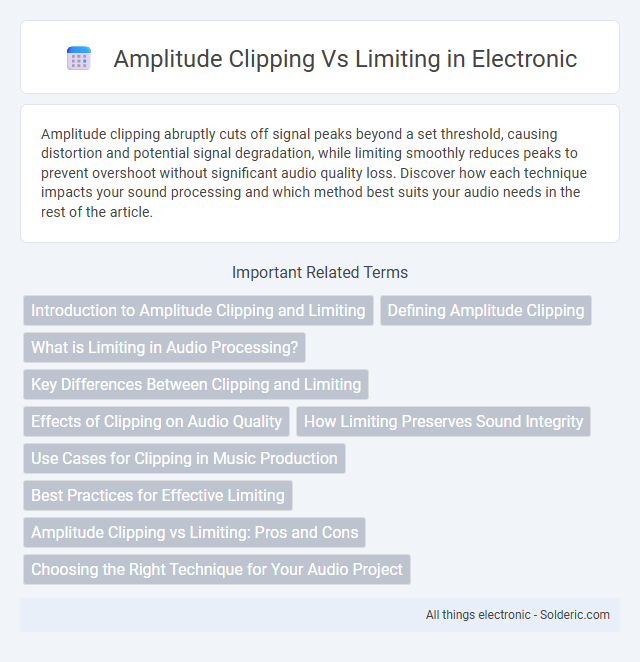Amplitude clipping abruptly cuts off signal peaks beyond a set threshold, causing distortion and potential signal degradation, while limiting smoothly reduces peaks to prevent overshoot without significant audio quality loss. Discover how each technique impacts your sound processing and which method best suits your audio needs in the rest of the article.
Comparison Table
| Feature | Amplitude Clipping | Limiting |
|---|---|---|
| Definition | Truncates audio peaks sharply beyond a set threshold. | Softly reduces audio peaks to stay below a set threshold. |
| Audio Quality | Can cause distortion and artifacts due to hard cutoff. | Preserves audio clarity by applying gentle gain reduction. |
| Use Case | Used for extreme peak control or creative effects. | Common in mastering to control dynamics smoothly. |
| Effect on Waveform | Produces flat tops on waveform peaks. | Maintains natural waveform shape with reduced peaks. |
| Dynamic Range Impact | Significantly reduces dynamic range abruptly. | Controls dynamic range gradually preserving balance. |
| Implementation Complexity | Simple to implement, no look-ahead needed. | Requires look-ahead and adjustable attack/release times. |
Introduction to Amplitude Clipping and Limiting
Amplitude clipping occurs when an audio signal exceeds a device's maximum threshold, causing the waveform peaks to be cut off and resulting in distortion. Limiting is a dynamic range control technique that reduces the signal's peak level to prevent distortion by setting a precise maximum output level. Understanding the difference between amplitude clipping and limiting helps you manage audio signals effectively to maintain sound quality and prevent unwanted distortion.
Defining Amplitude Clipping
Amplitude clipping is a form of signal distortion that occurs when an audio signal's amplitude exceeds a system's maximum threshold, resulting in the flattening or "clipping" of waveform peaks. Unlike limiting, which gently reduces signal peaks to prevent distortion, clipping abruptly cuts off the waveform, causing harmonic distortion and potential audio quality degradation. This process is critical to understand in audio engineering as it directly affects sound clarity and dynamic range.
What is Limiting in Audio Processing?
Limiting in audio processing is a dynamic range control technique that prevents audio signals from exceeding a specified threshold, ensuring peak levels do not cause distortion or overload equipment. Unlike amplitude clipping, which abruptly cuts off signal peaks causing harmonic distortion, limiting smoothly reduces gain as the signal approaches the threshold, preserving sound quality and preventing digital clipping. This process is essential in mastering and live sound to maintain consistent loudness while protecting speakers and recording devices.
Key Differences Between Clipping and Limiting
Amplitude clipping alters the audio signal by cutting off peaks exceeding a certain threshold, causing distortion and harmonic artifacts, whereas limiting controls gain dynamically to prevent signals from surpassing the set level without introducing distortion. Clipping results in harsh, possibly unpleasant sound due to waveform truncation, while limiting preserves the audio's natural dynamics by smoothly reducing transient peaks. Key differences include clipping's abrupt signal cutoff versus limiting's gradual attenuation, making limiting preferable for maintaining sound quality in audio production.
Effects of Clipping on Audio Quality
Amplitude clipping distorts audio signals by cutting off wave peaks, causing harsh, unnatural sound and introducing harmonic distortion. Unlike limiting, which smoothly controls dynamic range, clipping results in audible artifacts such as buzzing and reduced audio fidelity. Your audio quality suffers when clipping is applied excessively, making limiting a preferable choice for preserving clarity while preventing overloads.
How Limiting Preserves Sound Integrity
Limiting controls the audio signal by setting a maximum threshold, preventing distortion while maintaining the natural dynamics of your sound. Unlike amplitude clipping, which abruptly cuts wave peaks causing harsh artifacts, limiting gently reduces the volume of peaks above the set limit to preserve clarity and tonal quality. This process ensures your audio remains clean and professional without compromising the original sound integrity.
Use Cases for Clipping in Music Production
Amplitude clipping in music production is often used to achieve aggressive distortion effects and enhance harmonic content by intentionally driving signals beyond their maximum amplitude. This technique is popular in genres like rock, electronic, and hip-hop to create a raw, gritty sound that adds character and energy to vocals, guitars, and drums. Your choice between clipping and limiting depends on whether you want to preserve dynamic range with smooth peak control or achieve the pronounced saturation and edge that clipping provides.
Best Practices for Effective Limiting
Effective limiting requires setting the ceiling just below the clipping threshold to prevent waveform distortion while maintaining audio integrity. Utilizing look-ahead limiters helps anticipate and smoothly control transient peaks without introducing artifacts. Regularly monitoring gain reduction meters ensures balanced dynamics, avoiding the aggressive compression that can occur with excessive limiting.
Amplitude Clipping vs Limiting: Pros and Cons
Amplitude clipping aggressively cuts audio peaks exceeding a set threshold, producing distortion and potential signal degradation, beneficial for avoiding digital overload but detrimental to sound quality. Limiting smoothly controls peaks by reducing gain just before distortion occurs, preserving audio fidelity while preventing clipping, ideal for mastering and broadcast applications. Your choice depends on whether maintaining sound clarity or strictly controlling peak levels is more critical for your audio project.
Choosing the Right Technique for Your Audio Project
Amplitude clipping and limiting serve distinct functions in audio processing, with clipping creating sharp waveform truncations that can introduce harmonic distortion, while limiting smoothly controls peaks without significant waveform alteration. Choosing the right technique depends on the project's sonic goals: clipping may be suitable for aggressive, saturated sounds in genres like rock or electronic, whereas limiting is preferred for preserving audio fidelity in broadcast or mastering applications. Understanding the trade-offs between distortion and dynamic range control ensures optimal audio quality and prevents unwanted artifacts.
Amplitude clipping vs limiting Infographic

 solderic.com
solderic.com